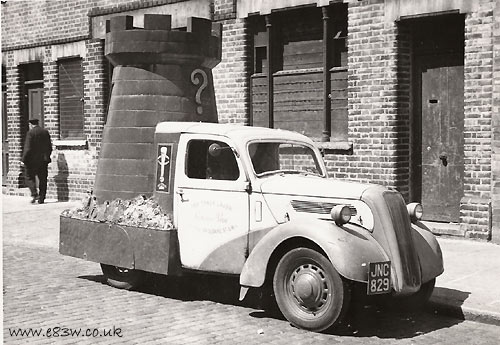Fordson 5cwt van.
Fords saloon based commercial
During the 10cwt E83Ws production run, there was an alternative Ford product aimed at small village businesses who didn't need the carrying capacity offered by the 10cwt. The E494C 5cwt sold well, and is popular today with the hot-rodding fraternity, especially in the USA where 5cwt vans seem to outnumber 10cwts by quite a degree.
But back to proper original-spec vans - the photo below was kindly sent in by Joseph who lives in Malta. The 5cwt shown below was purchased by his father sometime around 1949/1950, when fuel was still on ration after WW2. Many Maltese commercial vehicles, whether large or small, were richly decorated and featured ornate signwriting, lucky mascots, and accessories. The Fordson shown here has some such ornamentation, including signwriting (also on the rear of the van but not shown here), a lucky horseshoe, shiny chrome wing mirrors, and parking guides attached to the edges of the front wings. I wonder if 11507 is still around somewhere on the island???

The photo below, which I bought at a show a while back, shows a 5cwt with promotional rear body fitted. It looks quite dirty so has probably seen a fair bit of use.

This picture, from the Ford archives, shows a very early 5cwt vehicle (E04C) with suggested signwriting on the side, probably for use in a brochure at the time?

If there are any more nice original photos of 5cwts out there, by all means send them over and I'll feature them here too!! thanks
Potted 5cwt history
The earliest of the small 5cwt sidevalves was based on the Model Y in 1932, based largely on the contemporary Model Y saloon of the era. The Model Y 5cwt
lasted in production til 1937, when the 7Y 'Eight' came along. The 7Y 'Eight' variant set the style for subsequent upright 5cwt light vans and coachbuilt vehicles, with only superficial changes being introduced as the years rolled by. In Australia, some local-built van & 'ute' bodies were fitted to 7W 'Ten' chassis, but survivors are
decidedly thin on the ground.
After WW2 the 7Y light van became known as the E04C and was badged as a Fordson, in line with the larger 10cwt models, and continued until 1948. The E494C, as
seen in the photo above, was introduced in late 1948 and continued the established theme of earlier 5cwts, but now adopting a series of revisions including revised
grille treatment, and soldiered on til 1954, being outlived by the bigger E83W for around 3 years or so. As with the 10cwt, the 5cwt could also be purchased as a chassis/cab combination, or chassis/cowl, ready for bespoke coachwork to be fitted by companies such as Martin Walter, with their Utilecon estate model.
As with many E83Ws, it isn't unusual to find a vehicle that has received significant bodywork modifications over the years. Some vans, perhaps as a result of rear
accident damage or changing needs of their owners, find themselves cut down into pickups or other variations of body styling.
The Fordson E494C soldiered on in production until the arrival, in mid 1954, of the 100E based 300E 5cwt standard panel van. It would be another 3 years before the
big brother to the 5cwt, the E83W, was phased out in preference to it's successor, the boxy 400E Thames.
There will be some more 5cwt Fordson pics added here soon!
|

